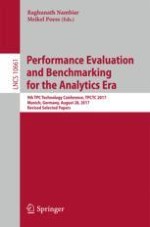2018 | OriginalPaper | Buchkapitel
JCC-H: Adding Join Crossing Correlations with Skew to TPC-H
verfasst von : Peter Boncz, Angelos-Christos Anatiotis, Steffen Kläbe
Erschienen in: Performance Evaluation and Benchmarking for the Analytics Era
Aktivieren Sie unsere intelligente Suche, um passende Fachinhalte oder Patente zu finden.
Wählen Sie Textabschnitte aus um mit Künstlicher Intelligenz passenden Patente zu finden. powered by
Markieren Sie Textabschnitte, um KI-gestützt weitere passende Inhalte zu finden. powered by
